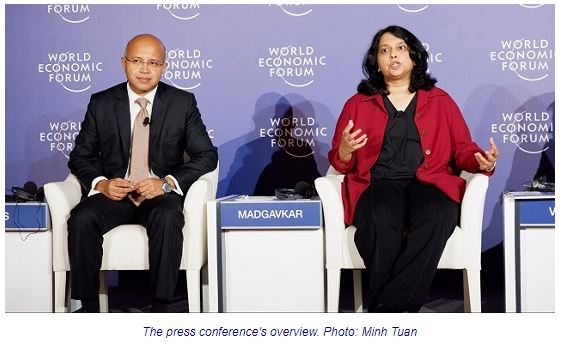Vietnam among 18 outperforming emerging economies
The Hanoitimes – Emerging economies have accounted for almost two-thirds of the world’s GDP growth and more than half of new consumption over the past 15 years yet, as individual countries, their economic performance varies substantially.
Vietnam has been classified among the best performing emerging economies, according to a new McKinsey Global Institute (MGI) report.
The report, titled “Outperformers: High-growth emerging economies and the companies that propel them”, identifies the emerging economies which have achieved a track record of stronger and more consistent growth than their peers and examines key factors determining their outperformance.
The report, titled “Outperformers: High-growth emerging economies and the companies that propel them”, identifies the emerging economies which have achieved a track record of stronger and more consistent growth than their peers and examines key factors determining their outperformance.
Of the 71 major emerging economies the report analyzes, 18 economies – about one in four – are classified as “outperformers”. Among those, seven achieved more than 3.5% per capita GDP growth over 50 years, between 1965 and 2016. They are China, Hong Kong, Indonesia, Malaysia, Singapore, South Korea, and Thailand.
Meanwhile, eleven others grew at a faster pace for a shorter period – 5 percent annually in the 20 years from 1996 to 2016. They are Azerbaijan, Belarus, Cambodia, Ethiopia, India, Kazakhstan, Laos, Myanmar, Turkmenistan, Uzbekistan, and Vietnam.
While these economies and individual policies differ, outperformers tend to have two fundamental elements in common, the report finds. The first is a pro-growth policy agenda that creates a virtuous cycle of productivity, income, and demand and which encourages savings, ensures stability, and fosters competition and innovation. The second is the outsized—and underappreciated—role of large companies in driving productivity and growth. “Development economists have studied and written a lot about policies that have driven growth in emerging economies, and of course good policy is a must,” said Jonathan Woetzel, a director of the McKinsey Global Institute who is also a McKinsey & Company senior partner in Shanghai, the report’s lead author.
Extending the winning formula of outperformers to all emerging economies could add US$11 trillion to the global economy by 2030, a 10 percent boost equivalent to the size of China, according to the report. Out of this, US$8 trillion would be the direct contribution from non-outperformers today, assuming they were able to achieve the same productivity growth rates as outperforming countries.
Looking forward, the report finds that the next wave of global growth can be led by a new set of emerging market outperformers that can on the one hand successfully drive pro-growth agenda while growing large productive firms and, on the other hand, adapt to changing global contexts. Manufacturing seems to be peaking earlier than it used to in developing countries, for example, automation is on the rise and cross-border trade flows have lost some of their dynamism since the 2008 financial crisis.
New anchor economies might emerge and create opportunities. For example, as China moves away from some labor-intensive manufacturing and toward more R&D-intensive manufacturing, it is creating opportunities for India, Vietnam and other emerging economies, especially for goods produced in low-income countries from Indonesia to Uzbekistan. Overall, the share of goods trade among emerging markets, both south-south and China-south, have risen from 8% in 1995 to 20% in 2016.
Meanwhile, eleven others grew at a faster pace for a shorter period – 5 percent annually in the 20 years from 1996 to 2016. They are Azerbaijan, Belarus, Cambodia, Ethiopia, India, Kazakhstan, Laos, Myanmar, Turkmenistan, Uzbekistan, and Vietnam.
While these economies and individual policies differ, outperformers tend to have two fundamental elements in common, the report finds. The first is a pro-growth policy agenda that creates a virtuous cycle of productivity, income, and demand and which encourages savings, ensures stability, and fosters competition and innovation. The second is the outsized—and underappreciated—role of large companies in driving productivity and growth. “Development economists have studied and written a lot about policies that have driven growth in emerging economies, and of course good policy is a must,” said Jonathan Woetzel, a director of the McKinsey Global Institute who is also a McKinsey & Company senior partner in Shanghai, the report’s lead author.
Extending the winning formula of outperformers to all emerging economies could add US$11 trillion to the global economy by 2030, a 10 percent boost equivalent to the size of China, according to the report. Out of this, US$8 trillion would be the direct contribution from non-outperformers today, assuming they were able to achieve the same productivity growth rates as outperforming countries.
Looking forward, the report finds that the next wave of global growth can be led by a new set of emerging market outperformers that can on the one hand successfully drive pro-growth agenda while growing large productive firms and, on the other hand, adapt to changing global contexts. Manufacturing seems to be peaking earlier than it used to in developing countries, for example, automation is on the rise and cross-border trade flows have lost some of their dynamism since the 2008 financial crisis.
New anchor economies might emerge and create opportunities. For example, as China moves away from some labor-intensive manufacturing and toward more R&D-intensive manufacturing, it is creating opportunities for India, Vietnam and other emerging economies, especially for goods produced in low-income countries from Indonesia to Uzbekistan. Overall, the share of goods trade among emerging markets, both south-south and China-south, have risen from 8% in 1995 to 20% in 2016.
Source: http://www.hanoitimes.vn/economy/industry/2018/09/81E0CC71/vietnam-among-18-outperforming-emerging-economies/


 English
English




